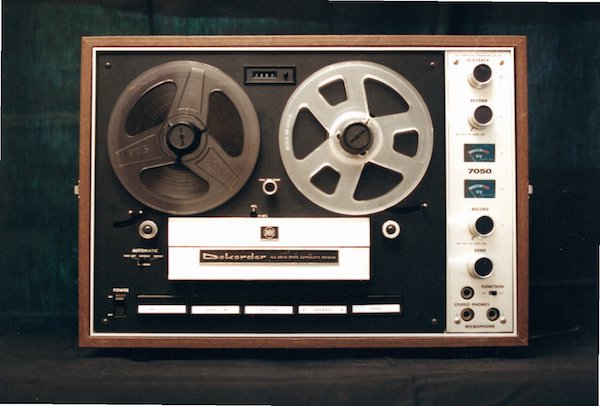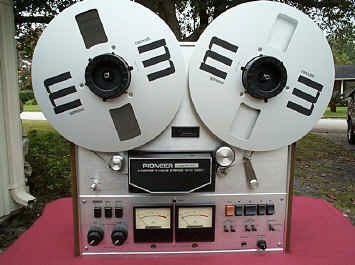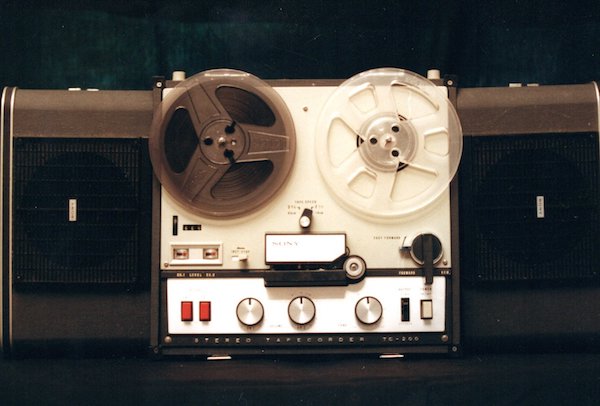(A photo from the internet, mine didn't look this good.)
Sony TC-105A
DESCRIPTION: A late '60s machine, this is a three speed, one motor, two head monophonic deck. It has a speaker built into the front of the machine, and a latchable cover. The case is covered in textured grey vinyl. There's nothing exceptional about the controls, except that is has the usual period-Sony "Instant Stop" lever which manually disengages the pinch roller without deactivating the playback electronics.
COMMENTS: This one was found in the snow outside after one of the auctions at the state surplus warehouse, another freebie. It's a very solid, basic little machine, but it has one big drawback: the fact that it's mono means that it doesn't play back stereo tapes very well at all. It would play one stereo channel very well, or get in between tracks and do very little. (It has a switch labeled "Track Exchange", with one side saying 1-4, and the other 2-3. The effect it seemed to have was that of moving the head gap to a different position vertically, I presume to work with stereo tapes. I could never get it to work satisfactorily, though. Mechanically, it's pretty basic, with the usual one motor idlers and belts, etc. The one thing to watch out for, though, is that Instant Stop lever. If its return spring is out of adjustment, it'll put too much pressure on the pinch roller and pressure pad, causing the tape to run slow. Alas, this one gave its life to help its bigger brothers in the collection.
Sony TC-200
DESCRIPTION: The second of the late '60s trio, this was a lower-level one motor, three speed, two head stereo deck with speakers which form part of the carrying case. It has the grey vinyl covering and the "Instant Stop" lever. It takes 7" reels, as do the rest of the Sonys listed.
COMMENTS: This deck was purchased through an ad in the local classifieds paper for $100.00 Cosmetically in excellent shape, this deck has had a very hard time with rubber idler wheel hardening, causing a slow running problem. I've taken it apart dozens of times and used rubber rejuvenator on the idlers, but it won't hold permanently. Apart from this problem, though, this unit has typically good sound quality, and a relatively compact design. This would be a good, low cost deck to listen to your old tapes on, as you can use the line out jacks to listen through a stereo, or you can use the built in speakers. (Note: these days I would go ahead and get the new rubber parts from Russel Industries/PRB Line, but back then I didn't have the patience.)
Sony TC-230
DESCRIPTION: The last of my '60s trio, this was the higher level stereo portable. It has the same one motor, two head, three speed design of the others.Unlike the 200, though, this deck uses much more metal in its construction, including nicely machined metal control knobs. It's bigger and more squared-off looking overall. This one also has the latchable speakers, but switching is provided so that a phonograph and tuner could be amplified through the decks electronics. Yes, it has the grey vinyl.
COMMENTS: A very nice machine, this one was given to me by a friend, who had recently had a friend of his pass away. I was told it was dead, because this gentleman in question had accidentally left it on all day one time, and it "burned out the motor". Upon inspection, I found that the motor wasn't dead, but it was extremely weak- running slow, and simply giving up in the fast wind modes. To make a long story short, I discovered that the run capacitor (1.5 f, 300V) had gone bad, making the motor run weakly and get very hot. The replacement cap made the deck run like new. A nice machine, this would also be good for listening to your old tapes (heck, it could be a nice apartment stereo- just add a CD player and a tuner!).



